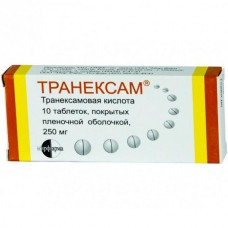Expiration date: 01/2026
The composition and form of issue:
Tablets, film-coated. 1 tablet contains:
tranexamic acid 250 mg
excipients:
microcrystalline, hydroxypropyl cellulose, sodium glycolate starch, talc, calcium stearate, Aerosil
shell — hypromellose, titanium dioxide, talc, polyethylene glycol 6000
in the contour packs of 10 in cardboard pack 1, 2, 3, 5 containers or jars polymer at 10, 20, 30 or 50 PCs the paper cartons 1 Bank.
The intravenous solution. 1 l contains:
tranexamic acid 50 g
excipients: water for injection up to 1 l
in the contour packs of 5 ampoules (5 ml) in the paper cartons 1 or 2 packs or in cartons or cardboard boxes for 20, 50 or 100 packs.
Description pharmaceutical form:
Tablets: biconvex, film-coated white color.
The solution for the on/in the introduction: the transparent or nearly transparent, colorless or light brown tint.
Pharmacokinetics:
Absorption in oral administration of doses in the range of 0.5–2 g — 30-50%. Tmax ingestion of 0.5, 1 and 2 g — 3 h, Cmax = 5 8, and 15 µg/ml, respectively. The plasma protein binding (profibrinolizin) — less than 3%.
Distributed in tissues relatively evenly (with the exception of the cerebrospinal fluid, where the concentration is 1/10 of the plasma) crosses the placental barrier in breast milk (about 1% of the concentration in the plasma of the mother). There are in semen, where it reduces fibrinolytic activity but does not affect the movement of sperm. The initial volume of distribution is L. 9-12 Antifibrinolytic concentration in various tissues is stored 17 h in the plasma of up to 7-8 hours
Metabolized a small part. Curve AUC has a three-phase form with a T1/2 in the final phase — 3 h (for solution for the on/in the introduction — 2 hours). Overall renal clearance is equal to plasma (7 l/h). Excreted by the kidneys (the main way — glomerular filtration) — more than 95% in an unmodified form for the first 12 h
Identified 2 metabolite tranexamic acid — N-azetilirovanie and deaminated derivatives. Impaired renal function there is a risk of accumulation of tranexamic acid.
Description pharmacological action:
Tranexamic acid — antifibrinolytic tool, specifically inhibiting the activation of profibrinolizin (plasminogen) and its transformation in fibrinolizin (plasmin). Has local and systemic hemostatic effect when bleeding associated with increased fibrinolysis (pathology platelets, menorrhagia), as well as anti-inflammatory, anti-allergic, anti-infective and anticancer action by inhibiting the formation of kinins and other active peptides involved in allergic and inflammatory reactions. The experiment confirmed their own analgesic activity of tranexamic acid, as well as sverhsekretnye potentiating effect on the analgesic activity of opiates.
Indications:
Common to both dosage forms: haemorrhage or risk of bleeding against the background of increased fibrinolysis, as generalized (bleeding during surgery and in the postoperative period, postpartum hemorrhage, manual separation of the placenta, the chorion detachment, bleeding in pregnancy, malignant neoplasms of pancreas and prostate glands, hemophilia, hemorrhagic complications of fibrinolytic therapy, thrombocytopenic purpura, leukemia, liver disease, previous treatment with streptokinase) and local (uterine, nasal, pulmonary, gastrointestinal bleeding, hematuria, bleeding after prostatectomy, cervical conization about cancer, tooth extraction in patients with hemorrhagic diathesis).
For tablets more:
- hereditary angioedema
- allergic diseases (eczema, allergic dermatitis, urticaria, drug rash and toxic)
- inflammatory diseases (tonsillitis, pharyngitis, laryngitis, stomatitis), and aphthae of the mucosa of the oral cavity.
For solution for I/V administration advanced:
- surgery on the bladder
- surgical procedures when systemic inflammatory response (sepsis, peritonitis, pancreatic necrosis, severe and moderate preeclampsia, shock of various etiologies and other critical state).
Contraindications:
- hypersensitivity to the drug
- subarachnoid hemorrhage.
With caution:
- thrombosis (thrombosis of cerebral vessels, myocardial infarction, thrombophlebitis) or the threat of their development
- thrombohemorrhagic complications (in combination with heparin and indirect anticoagulants)
- violation of color vision
- hematuria from the upper urinary tract (possible obstruction of a blood clot)
- renal failure (possible accumulation).
Side effects:
Common to both dosage forms: there may be nausea, vomiting, heartburn, diarrhea, rash, pruritus, decreased appetite, drowsiness, dizziness. May occur violation of color vision, and rarely thrombosis, thromboembolism.
For solution for in/in the introduction of additional hives, weakness, drowsiness, tachycardia, pain in the chest, gipotenzia (with the rapid on/in the introduction), the lack of visual perception.
Drug interactions:
Total for both dosage forms: with the combined use of hemostatic drugs and preparations gemokoagulaza possible activation of thrombosis.
For solution for I/V administration advanced: pharmaceutically incompatible with blood products, fluids containing penicillin, urokinase, hypertensive funds (norapinefrinom, deoxyepinephrine hydrochloride, determine bitartrata), tetracycline, dipyridamole, diazepam.
Method of application and dose:
Pills
Inside.
With local fibrinolysis — for 1.0–1.5 g 2-3 times a day.
With profuse vaginal bleeding — for 1.0–1.5 g 3-4 times daily for 3-4 days.
With repeated nasal bleeding, and 1 g 3 times a day for 7 days.
After surgery, cervical conization — 1.5 g 3 times daily for 12-14 days.
Patients with coagulopathy after tooth extraction — 25 mg/kg 3-4 times a day for 6-8 days.
When hereditary angioedema is 1-1. 5 g 2-3 times a day continuously or intermittently depending on the presence of prodromal symptoms.
Solution for the on/in the introduction
In/in (drip, jet).
In a generalized fibrinolysis is administered at a dose of 15 mg/kg every 6-8 h the infusion rate of 1 ml/min.
If local fibrinolysis is recommended the drug in a dose of 250-500 mg 2-3 times a day.
When prostatectomy or surgery for bladder injected during operation 1 g, then 1 g every 8 hours for 3 days, then transferred to the ingestion of preformed shape until the disappearance of gross hematuria.
At high risk of bleeding with systemic inflammatory response at a dose of 10-11 mg/kg 20-30 min before the intervention.
Patients with a coagulopathy before extraction of the tooth is administered at a dose of 10 mg/kg, after extraction of a tooth is prescribed ingestion of a tablet form of the drug.
In case of violation of renal excretory function required a correction mode, depending on the concentration of creatinine in the blood: when the concentration of creatinine in the blood 120-250 mmol/l administered with 10 mg/kg 2 times a day for 250-500 µmol/l and 10 mg/kg, 1 time per day >500 µmol/kg and 5 mg/kg 1 time per day.
Special instructions:
Before and during the treatment the necessary examination of the eye (definition of visual acuity, color vision, ocular fundus).




